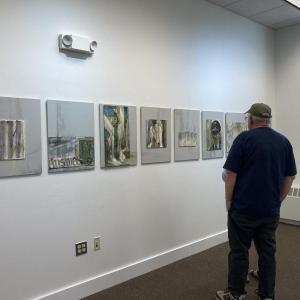Brenda Bettinson 'Ravensbrück Series'
Brenda Bettinson’s Ravensbrück Series is currently on display at the Holocaust and Human Rights Center (HHRC) in Augusta through Sept. 5.
There you can view in Dr. Sarah Foulger’s words “This momentous series of paintings, the final resonant chord in the music of Brenda Bettinson’s life […]”. A collection of 17 paintings conceived as a traveling exhibition represents Bettinson’s last sonorous visual statement. This body of work was first exhibited at Pace University, Pleasantville, New York in April 2024 and now has its first public showing in Maine. The Maine exhibition has been augmented by Bettinson’s Self Portrait (2008) and the recently completed bronze of Bettinson’s death mask (at the Green Foundry in Elliot), which was unveiled at the opening reception in June.
In this series, Bettinson dramatizes life and death in what is often referred to as Hitler’s Concentration Camp for Women ("Sarah Helm Life and Death in Hitler’s Concentration Camp for Women," 2016, Penguin Random House). Themes imbedded in Bettinson’s Ravensbrück Series are variations on the mistreatment of women: intimidation, beatings, starvation, and other forms of deprivation, medical experimentation, aggravated solitary confinement, public hangings, slave labor, desecration of corpses. While this litany of horrors may sound terrifying and anything but inviting, the exhibition offers the viewer a dedicated quiet space to meditate and perhaps begin to come to grips with what took place in this and other Nazi concentration camps.
While imbued with a quiet palette of grays and greens it offers contrasts of striking reds and blue and a variety of shades of yellow. The sequence of the individual works is important; paintings #1 - #4 constitute a preamble, the instrument of martyrdom, if you will, and these panels are displayed at an angle to the others. Panels #5 - #17 are visually connected from left to right through a color continuum, which leads the eye from one painting to the next. Within this group one may observe that the color of the central part of each panel seeps vertically into the background. Panels #5 - #15 deal with aspects of existence and survival whereas panels #16 - #17 can be understood as a coda, dealing with death and remembrance. This structure holds the works together while also setting a pace for viewing. Also holding the series together is a sense of purpose and determination that the painter offers together with a commitment to a life-sustaining esthetic.
Bettinson’s Ravensbrück Series is more than the sum of its parts, rather it is a summery of what has long preoccupied this painter: 1) the human figure as a vehicle to examine the human condition, 2) observation of the natural and material world leading to something more than a mere copy, and 3) taking up the challenge to contribute a new painterly idiom that evolved from being deeply grounded in tradition.
Art historian Genetta McLean in her essay, "Brenda Bettinson: A Paragone On Pictorial Space," connects Bettinson’s work with that of 14th century Italian painting: “Her work is a worthy descendent of the great tradition of Italian painting – experimental and probing, and the artist herself embodies the vibrant intellectual curiosity that was so highly championed by this era.”
For more information about this exhibition, visit www.hhrcmaine.org.




























